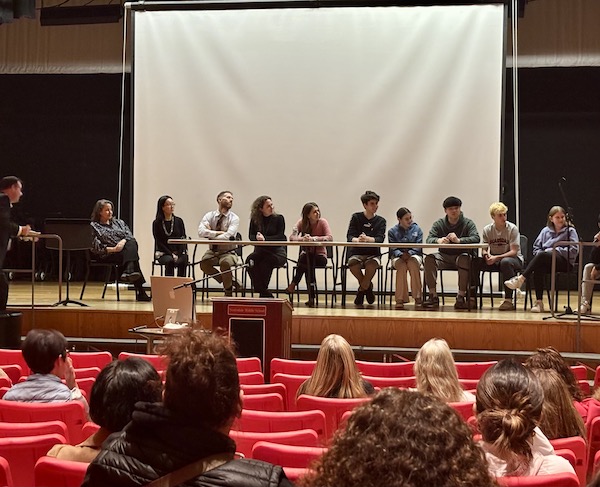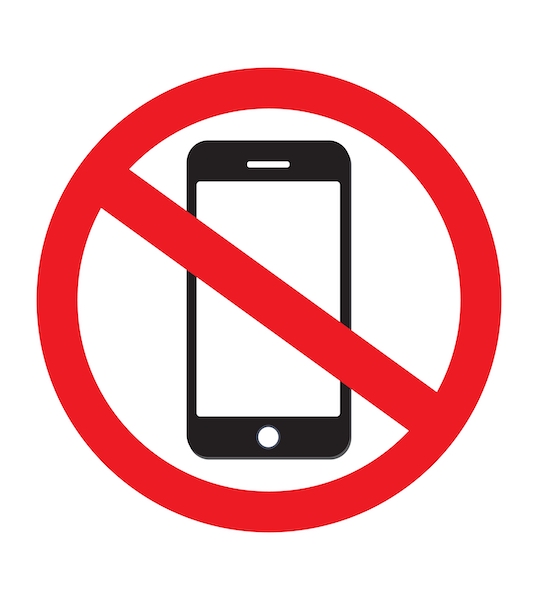District Assesses "Off and Away" Smartphone Policy in Schools
- Sunday, 24 November 2024 11:25
- Last Updated: Sunday, 24 November 2024 11:40
- Published: Sunday, 24 November 2024 11:25
- Sharon Higgins
- Hits: 2399
 Technology and in particular smartphones are not going away. However from the SHS/SMS joint presentation on November 20, “Phone Smart: How Can We Support our Youth in the Smartphone Era?” itis possible that future Scarsdale students will benefit from a policy that will have them putting their phones away from “bell to bell”.
Technology and in particular smartphones are not going away. However from the SHS/SMS joint presentation on November 20, “Phone Smart: How Can We Support our Youth in the Smartphone Era?” itis possible that future Scarsdale students will benefit from a policy that will have them putting their phones away from “bell to bell”.
The evening’s panel discussion, with an introduction made by Scarsdale Schools Superintendent Drew Patrick, highlighted the impact smartphones and social media have in our classrooms. Patrick talked about the challenges of smartphones and how “living” with technology and smartphone use would need to be a partnership between teachers, students and parents. He presented a short video taken at a conference this summer addressing this issue with Governor Hochul, various New York state teachers organizations representatives and students from across the state who gave soundbites on the harm smartphones have on students of all ages. Patrick noted that the surgeon general claims 95% of 13-17 year olds report using social media. And what that really means is that these kids are constantly getting beeped and buzzed throughout the day urging them to look and respond to a small screen that is attached to them at the hip.
Governor Hochel supports a “bell to bell” ban (8am-3pm) on all personal internet devices and feels it should be uniformity from class to class. Currently there is an Off and Away school policy in Scarsdale. For elementary school, children's phones and smart watches ideally should not be brought to school at all but if necessary, they should be turned off and put away in their backpacks. At Scarsdale Middle School, smart watches do not need to be put away but phones are left off and away in lockers. At the high school, students enter each class and place their phones in the phone caddy at the entrance of the class to be picked up at the end of class on their way out at the end of the period.
SHS English teacher Jennifer Rosensweig, helps to lead the district on the current school policies on smartphone use. At the meeting, she invited a panel of SMS and SHS students and faculty to discuss their opinions on smartphones and social media and their effects in the school setting. Rosensweig insists that both her experiences and observations as a teacher at SHS and the many studies she has researched over the years, technology has a negative impact on students.
She explained that in 2015 she started noticing a drop off in reading ability which led her to start looking at data on screentime of the adolescent mind. Since then it has been “a long journey of research”. She states that “the research is so strong, we can’t look away”. She refers to her personal experience with over 1,500 students where she has seen a difference in concentration, sleep habits and even an increase in anxiety. Students are now starting to ask for help with this issue. As a member of the SHS wellness committee that implemented the start of the phone caddy systems last year, she has received reports from teachers that the program has given them back their classrooms. Rosensweig says phone caddies “make a difference but not enough”. She adds that it is not realistic to eliminate smartphones altogether; however each student needs seven hours a day without pings and buzzes calling out to them.
As each of the student and teacher panelists were asked questions by Drew Patrick on their personal smartphone use, it was very clear from their answers that nobody thinks it’s a good idea to have smartphone access during the school day. One student commented that a “phone cleanse makes my day better. I can think better and just do more”. Another said that “without the phone it felt mentally refreshing. I can enjoy my classes, clear my mind during the day and have great conversations at lunch with my friends”. One student admitted that she “goes straight on it after class in the hallway and is on it the whole walk to my next class. I don’t even look up”. Rosensweig inserted that in her research she found that students “need down time between classes to absorb the information just taught and if they look at a screen that information is immediately lost”.
At one point a student exclaimed that smartphone use “is an addiction. I get a craving to be on it”. Having phones in the phone caddies this past year and a half, teachers have seen some real progress. In fact, one teacher commented that there has been “an enormous reduction in bathroom trips and they are far quicker”. Rosensweig also cautions us to be wary of “hyperbolic language for the threat of an emergency when students feel obliged to answer texts from parents.” She added that ipads and laptops also have social media messaging. A math teacher commented that in her class, she doesn’t really need technology except to submit scanned homework which takes all of 60 seconds. However, she does notice that when she returns tests at the end of class there is a mad student dash to retrieve their phones. She informs her students they don’t need to use their phones to calculate their grade percentages! There was definitely a chuckle or two from the audience here. But her story relates to Rosensweig’s comment that this is “not a children’s problem to solve”. Recognizing this, the district's Technology Department has been working very hard to figure out a balance between the technology smartphone use in the school and also how teachers use technology in the classroom.
The last question directed to the members of the panel was, “If you could change something why and what would you do?” Overwhelmingly the panel asked for a “more unified effort to keep phones off and away”. Rosensweig’s last words were of gratitude to be at this event and though she would like to see more progress, she believes we have come a long way already. She is glad that the community is talking more honestly about this and reiterated that kids deserve a more communicative and cooperative learning experience.
Drew Patrick closed the evening discussion with information on the Bell to Bell without phones program implemented in the Bethlehem Central School District. In this school district phones brought to school go in Yondr pouches and are sealed up as they enter school. The pouches demagnetize the phones in the sealed pouch. As the students leave for the day they unlock the pouch at exit stations to retrieve their phones from the pouches.
The Yondr pouches caused a change in social student connectedness. Drew Patrick sees the smartphone policy as a partnership between the schools and parents. “We can’t do this alone” he stated. “There is not a big solution” at the moment but he is hopeful for “a discussion for future dialog.”
Last, he directed parents who would like help with conversations with their children about smartphone use to the Scarsdale Family Forum pages. The Scarsdale Family Forum was designed and supported by the district’s Technology Department to help parents, teachers and administrators to start discussions on challenging issues.







